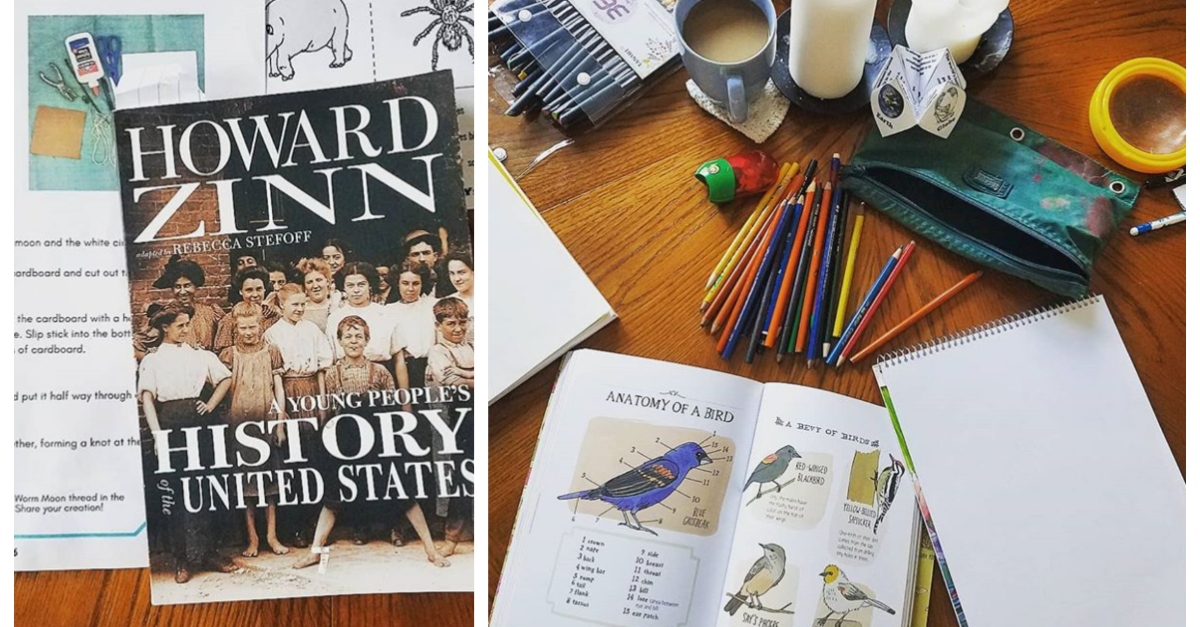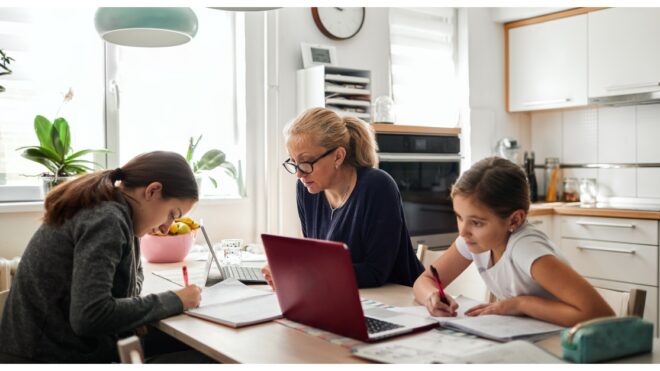
My son has been homeschooling since first grade, after we moved across the country and were promptly informed by our neighborhood school that it did not feel prepared to adequately provide resources needed to navigate his three chronic health conditions. We intended to find him a different school to attend after that first semester but somehow just never got around to it. Homeschooling was never seriously on our horizon, and, like many homeschooling parents, we stumbled and fumbled and have, eventually, found something that works for us.
A lot of homeschooling parents definitely go through a bit of a process before they land on a system that makes sense for their kids. Part of this is that homeschooling your child means that you have to de-school yourself — you have to completely let go of the expectation that "school" looks only one way. Often, that one way is however you experienced school as a child. I was definitely guilty of clinging to this idea, to the point that my son's first year of homeschooling was very scheduled, with color-coded times for various activities, and he even had a little desk to sit at.
It was cute! But it was also not realistic, and I realized about halfway through the school year that we were making this way too hard on ourselves. And that's really easy to do, because when you decide to homeschool your child, you're deciding to take on a huge load of responsibility that would otherwise fall onto someone who is trained and paid to do it (I love you, teachers).
I spent the first year or two determinedly sticking to curriculum that I found online, making sure that he was properly exposed to all of the "essential" subjects and that I rigidly followed the guidelines published by the state that we lived in. And then he hit third grade, and it became very obvious this system wasn't working for anyone in the home. So I decided to do what any reasonable homeschooling mom would do and just blew it all up.
Homeschool truth: There is no one way to homeschool.
If there is one thing that took me forever to learn and that I really wish I could impart on my friends who are new to homeschooling, it's that there is no one way to homeschool in the first place. While now I can solidly describe my son as a self-directed unschooler, it took a long time to get here (and unschooling isn't for everyone).
Maybe you really, really like the idea of sticking to your state's education standards strictly, and you like the idea of setting school hours from 9 to 2, and you like the idea of making sure you hit every little subject every day, just like they do in regular school. That's great! But it's not going to make your child magically smarter or more advanced than another kid. It also isn't the only way you can homeschool.
Maybe you really, really like the idea of "they'll learn it when they want to" (by the way, this has been proven to be true in my son's life over and over again, with everything from math to reading to handwriting). Maybe you really believe that children should be allowed to run free and pick and choose what they learn and when they want to do it. Bomb! You are braver than I am, and this also isn't the only way you can homeschool.
Also, it's worth noting that there are obviously about 456,729,821 other options in between those two.
Make it up if you want to.
One of those options is the one I deployed last year: totally making up every single part of the homeschool curriculum. The fact that I even typed that sentence really demonstrates how I have changed as a homeschooling mom. I definitely began this journey with one set of expectations and rules, and I am now happily floating far to the left of that particular moment in time.
When I say that I "made up" his curriculum, I mean that I pored over a ton of resources available and just cobbled together something that resembled an educational plan, with the understanding that his interests would take us where we wanted to go.
Fill in the gaps yourself.
The whole reason I even eschewed the idea of sticking with just one curriculum was that I really wanted my son's fifth-grade experience to be heavy in US history. When I started looking at the options available to us, I realized that none of the stuff I found was quite as honest as I felt his US history lessons should be.
So I found two books that have since become cornerstones in our homeschooling journey: A Young People's History of the United States and A Different Mirror for Young People: A History of Multicultural America. I reference these books, both in conversation and in regular life, so frequently that I am sure people get bored of hearing about them. But the books are incredible, and they opened up both of our eyes and minds to parts of US history that neither of us had ever learned about. I initially tried to use the Teachers Pay Teachers site to find lessons that corresponded to each book's chapters, but I often found that there weren't a lot of lessons that engaged as fully as those two books do. So I ended up making up my own.
I was so excited about beginning to read those books that I then decided to just go ahead and make up everything else.
Homeschool resources for fifth grade
In addition to those books, I used quite a few resources to pull together a fifth-grade year that worked for us:
Handwriting and typing:
Spelling:
Foreign language:
- italki (He takes French and Spanish.)
English/language arts:
Science: We have always used a ton of different resources here. My kid is way into science (he loves wildlife biology) and hopes to study it his entire life. He doesn’t really have a grade level when it comes to science — he has taken online college-level courses, we have used resources like this “Teaching Kids About Fish Migration” lesson from the US Fish and Wildlife Service, we’ve bought science textbooks, he’s been in forest school classes for years … we engage in science often and in a very hands-on way.
Math: My son skipped math for a year (we ran into some major roadblocks and just decided to … not), and so we ended up signing him up for Mathnasium last year. It's expensive ($319 a month), but he loves it, and he's made huge gains in the time since. There are lots of free and low-cost math options out there, but he expressed an interest in (a) understanding math, (b) becoming very good at math, and (c) progressing beyond his grade level in math. He's now accomplished part of the list and is working toward the third. I love Mathnasium, and it has a fully remote option available.
There are also tons more options out there. This is just a sampling of the resources I used to put together something that made sense for us, and it's definitely not comprehensive.
How it all went
In the end, it was a really fun year! However, every so often I definitely felt like things were a little chaotic, and sometimes I worried that we were forgetting some crucial element. I think some of that was just fear talking, but this coming year we are going to bridge the divide between a standard curriculum and making it up as we go along.
We will use some of our favorite things from last year, and we have also bought two new things that I'm really excited about: the secular Woke Homeschooling curriculum and the Global Village Guide for sixth grade. I am particularly excited about the latter, as I have followed along with Global Village School for a while and really love its mission. We will also be reading Disability Visibility together and are both looking forward to what we will learn in that book.
In the end, the biggest thing I learned is that when it comes to homeschooling, the most important thing to remember is that staying flexible is key. Make it up, don't, or do something else entirely, but don't get too stressed about it in the process.







